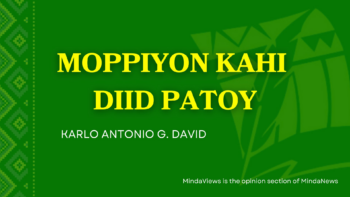
CEBU CITY (MindaNews / 8 November)—The generation whose coming of age coincided with the youth-quake that rocked the whole world with reverberations in Third World countries like the Philippines gave birth to youth social movements that impacted the contemporary histories of many nations.
This was the period which brought many young people marching in the streets to protest against the US brutalities committed against the Vietnamese people during the infamous Vietnam War. That war drove the Americans soldiers out of Vietnamese soil with the victory of forces led by Ho Chi Minh, a major defeat for the imperialist country. At the same time, the civil rights movements in the US also fueled the rage of those opposed to racism.
The anti-Vietnam war sentiment spread across the world and in the streets of Manila, students marched towards the US Embassy along Roxas Boulevard to join the global youth resistance against US imperialism. Other issues that became a major concern for those drawn to the activism of that period included the feudal structures that remained in place owing to the absence of a genuine land reform program and the creeping corruption and cronyism in the Marcos administration even before martial law was declared in 1972.
It was a period when the Filipino youth became far more nationalistic compared to their elders who—brainwashed by their belief in the benevolence of the Americans who fought against the Japanese during WWII and reinforced by an educational system that perpetuated the myths of colonization—were generally antagonistic to their children becoming activists. The 1960s-80s youth generation studied Marx, read the history books of Agoncillo and Constantino and held teach-ins on the root causes of the country’s ills. They sang songs that were appropriated from the revolutionary fervor of the past like Bayan Ko, or composed by radical songwriters like Heber Bartolome and Jess Santiago.
This was the generation that would make history in the same way that the nation’s youth in the 1880-90s from the students and journalists who were in Spain—e.g., Graciano Lopez Jaena who founded La Solidaridad that gave birth to the Propaganda Movement—to Gregorio del Pilar and those who actually fought the revolutionary war. Andres Bonifacio mobilized young fighters to join the KKK which eventually ripped the shackles of Spanish colonial rule.
It was the turn of the 1960s-80s generation to carve their niche in Philippine contemporary history when they massed in the streets outside the old Congress (now the National Museum of the Philippines) on January 26, 1970. Ferdinand Marcos was finishing his second-term as President and he was giving his State of the Nation Address that day. Tens of thousands of students gathered to protest against what they considered the failure of the Marcos administration to address the nation’s social ills.
Despite peacefully holding their rally, countless fully-armed military and police who were strategically positioned on alert around Congress were provoked to attack the students. As the students surged to fight the military, bullets were shot at the protesters, killing four students. Scores were hurt in the skirmishes that followed. This began the First Quarter Storm of the 1970s which was a period of civil unrest where students further organized their ranks. At UP Diliman an uprising known as the Diliman Commune took place during the first week of February 1971 where the protesters clashed with the police and military.
From Manila, the student protest movement spread to the provinces. In many school campuses, there were also a surge in the youth’s interest to get involved as they held teach-ins and looked into their own local social issues. Things stood still temporarily when martial law was declared on September 21, 1972 even as some of the youth joined the underground. But within just a few years later, the youth movement would sweep across the country.
Across the 14 years that Marcos held absolute power, unrelenting occurrence of brutalities committed against the Filipino people persisted. By the end of his dictatorial government, some 70,000 people were imprisoned, 34,000 were tortured and over 3,200 people were killed, according to Amnesty International. While the victims ranged from peasants to urban poor and indigenous leaders, there were also many young people whose lives perished during this dark period of the country’s history. Rightfully, they are considered the nation’s heroes and heroines and a number of them are honored at the Bantayog ng mga Bayani.
One of the sectors to whom the Filipinos owe a debt of gratitude for their heroic resistance to the martial rule were those in media, especially the journalists. At the height of martial rule, women journalists took center stage, including Arlene Babst, Ninez Cacho-Olivares, and Melinda de Jesus who had a shared column in The Manila Bulletin. Younger journalists would take over from those who pioneered militant journalism in the early years of martial rule. They all adhered to what Noam Chomsky, the famous writer and social theorist who is considered the father of modern linguistics who wrote: “The duty of journalists is to tell the truth. Journalism means you go back to the actual facts, you look at the documents, you discover what the record is, and you report it that way.”
A number of them came from the provinces or were active in investigative journalism in their local settings. One of them was born in Naga City on May 27, 1951 who also belonged to the 1960s-80s generation who got radicalized when martial law became a period of deep discontent for the youth of the land. Conrado de Quiros would rise from the ranks to become perhaps one of the best-read columnists in the contemporary history of Philippine journalism
When news was posted in social media on Monday, November 6 by Paul de Quiros, announcing the death of his brother Conrado and consequently reported extensively in mass media, it sent shock waves across the country, especially among the journalist’s countless fans who followed his PDI column for years. “Rock on in heaven, Choy!!” was how Paul ended his short write-up. There was no question that Conrado rocked across the hundreds of articles he had written in his column “There’s the Rub” appearing in the pages of the PDI a number of times week after week. He began writing this column in the defunct Philippine Daily Globe in 1987 before he transferred to PDI in July 1991 and stayed on the job years before the pandemic.
In his column, he was fearless in attacking the powers-that-be from Marcos and through the Presidents across the different administrations that followed Mrs. Cory Aquino, the abuses of the cronies and crooks in government, the abusive military and the greed of the corporate world.
Conrado never compromised the truth; he called a spade a space. He was willing to face the risks involved in being a fearless columnist to write nothing but the truth. And he was not concerned who got lambasted in the process. For as the American writer, reporter and political commentator, Walter Lippman wrote: “There can be no higher law in journalism than to tell the truth and to shame the devil.”
However, he also did reviews of books and cultural events, about the beauty of nature and the travails of the urbanite living in polluted Manila. He waxed sentimental about his hometown when he wrote: “My own hometown is Naga City, though I was born in Manila. It is where I spent my boyhood and adolescence and learned my first language, which is Bicol. It is where I go to charge my psychic batteries. I barely know anybody there anymore from childhood. But the place itself holds a raging volcano of memories for me. Which sends electrical surges through my soul. Hometowns give you a sense of bearing in a world—especially so this country—seemingly drifting in space, bound for nowhere.”
He also explored creativity in his column. Twice, his readers saw a blank space in his column, as his way of indicating his sarcasm and contempt. He did this in 2004, as a way to criticize Fernando Poe Jr.’s attempt to run as President and also to show his displeasure with President Gloria Macapagal-Arroyo. If memory serves me right, he also wrote in one column how difficult it was on some days to produce his column in time for the deadline.
One can imagine how he managed to do it—for countless years writing those thought-provoking columns one after another.
When he stopped writing his column after he suffered a stroke in 2014 and needed medical care, his loyal fans were saddened. Since then, he had been confined in a wheelchair. A shy person in actual life who did not want the spotlight on him, his appearance in public became ever rarer. His countless fans were in a withdrawal syndrome as they had been used to seeing his columns for a number of years. It was an understatement to say that his loyal readers missed his wit and sarcasm written in excellent prose. His absence created a vacuum in PDI that so far no other journalist of the same caliber has been able to fill.
While writing his column, Conrad also wrote a number of books including: Tongues on Fire, Dead Aim: How Marcos Ambushed Philippine Democracy, Flowers from the Rubble, Dance of the Dunces, The February Revolution: Three Views and The Bird-Catcher Was a Poet: The Life and Passion of Eduardo A. Makabenta Sr. He was also invited to give talks especially on the challenges of journalists facing censorship and even the threat of arrest as well as giving national situationers. But he would be the first to tell his fans that he was better read than heard because he never impressed his listeners with his eloquence.
When I first heard that he had passed away early Tuesday morning, it brought sadness although I thought it was best for him now that he was beyond pain and the inconvenience of ill health. I comforted myself in the thought that this very courageous, kind and fearless person would have gone straight to heaven to join the saints whose lives on earth were exemplary following the Gospel’s call to preach truth and justice!
Then I recalled the first and the last time I met him. I couldn’t exactly remember the dates but I first met him at the residence of Ed and Ching Gerlock in Quezon City where I would stay a day or two when I went to Manila. I was then involved in our mission work in San Fernando, Bukidnon where the peasants staged a people’s barricade to block the passing of logging trucks coming from the logging camps to transport the round logs to the port in Cagayan de Oro. Carol Arguillas of The Manila Chronicle was covering this story and he read about them in the papers.
When he heard I was in Manila, he called me and asked for an appointment. We met one morning and I updated him on what was taking place in San Fernando and he wrote a piece on this. In another occasion, I visited him at his residence in a BLISS building in Quezon City. I was struck by how modest his lifestyle was and was already very much impressed by his journalistic competence. Even when he was not yet a known journalist, I already knew he would go places. And he did in the years to come.
He was on his wheelchair when I last saw him. I do not remember the exact venue, but I think it was during a theatrical production sponsored by the AMRSP. He naturally attracted the crowd’s attention and a number of us approached him to say Hello. He acknowledged us, had a smile on his face but it was clear it was not possible to have a long chat with him. Between that time and the announcement of his death, I did wonder what had happened to him. I only wished that he had the medical attention he needed.
Up to the end of his active journalism career, Conrado continued to be the prophetic voice in the wilderness of public sphere. He was impassioned with his belief that he had a great responsibility as a journalist to help build a free and sovereign nation. For as Walter Cronkite, who was also a columnist who coined the term “cold war,” posited: “Journalism is what we need to make democracy work!”
We salute you Conrado, truly you are a modern Pinoy hero! And God speed as you embrace eternal rest in God’s bosom!
(MindaViews is the opinion section of MindaNews. Redemptorist Brother Karl Gaspar is Mindanao’s most prolific book author. Gaspar is also a Datu Bago 2018 awardee, the highest honor the Davao City government bestows on its constituents. He is presently based in Cebu City).







